
Journal of Spine Practice
ISSN: 2789-9462
Leading research in all spine subspecialties focusing on orthopaedic spine, neurosurgery, radiology, and pain management.
Scoliosis secondary to herniated lumbar disc in an adolescent: A case report
Published date: Jul 19 2022
Journal Title: Journal of Spine Practice
Issue title: Journal of Spine Practice (JSP): Volume 1, Issue 2
Pages: 83 - 89
Authors:
Abstract:
Background: Herniated nucleus pulposus is infrequent among children and adolescents. The first case of surgical intervention for disc herniation was reported in a 12-year-old child. Since then, very few cases or series of cases have been published. The current case report is of a 15-year-old girl with no history of spinal ailment, who presented with a large disc herniation in the L4–L5 region, associated with reactive secondary scoliosis and resolved following a successful surgical intervention.
Case Description: A 15-year-old female with a known case of scoliosis and a history of lower back pain for nine months following a fall while playing football, without any past account of the spinal disease, was presented at the outpatient clinic. After a series of proper imaging, a large L4/5 HNP with positional secondary scoliosis was diagnosed. However, due to the persistence of symptoms for more than two months in radiculopathy and reactive scoliosis, the decision was made to proceed with L4/5 microscopic discectomy. After six months, the neurological examination was normal, with a significant improvement of scoliosis with the restoration of normal spine alignment seen in plain X-ray films. The right leg radiculopathy improved as well.
Conclusion: Lumbar disc herniation in association with scoliosis needs a vigilant evaluation of signs and symptoms and appropriate diagnostic imaging. Imaging is vital in diagnosing underlying disease states and helps in clinical management and surgical planning. The appropriate treatment is a discectomy.
Keywords: Scoliosis, Lumbar, Adolescents, Spine
References:
[1] Børgesen SE, Vang PS. Herniation of the lumbar intervertebral disk in children and adolescents. Acta Orthop Scand 1974; 45(1–4): 540–549.
[2] Grass J, Dockendorff IB, Soto VA, Araya PH, Henriquez CM. Progressive scoliosis with vertebral rotation after lumbar intervertebral disc herniation in a 10-year-old girl. Spine 1993; 18(3): 336–338.
[3] Matsui H, Ohmori K, Kanamori M, Ishihara H, Tsuji H. Significance of sciatic scoliotic list in operated patients with lumbar disc herniation. Spine 1998; 23: 338–342.
[4] Pinto FCG, Poetscher AW, Quinhones FRE, Pena M, Taricco MA. Lumbar disc herniation associated with scoliosis in a 15-year-old girl: Case report. Arq Neuropsiquiatr 2002; 60(2A): 295–298.
[5] Ha BY, Sim HB, Kwon SC, Lyo IU. Lumbar disc herniation associated with severe scoliosis in young age: Report of three cases. Korean J Spine 2010; 7(2): 87–89.
[6] Kurihara A, Kataoka O. Lumbar disc herniation in children and adolescents. A review of 70 operated cases and their minimum 5-year follow-up studies. Spine 1980; 5(5): 443– 451.
[7] Dang L, Liu Z. A review of current treatment for lumbar disc herniation in children and adolescents. Eur Spine J 2010; 19(2): 205–214.
[8] Sarma P, Thirupathi RT, Srinivas D, Somanna S. Adolescent prolapsed lumbar intervertebral disc: Management strategies and outcome. J Pediatr Neurosci 2016; 11(1): 20.
[9] Rugtveit A. Juvenile lumbar disc herniations. Acta Orthop Scand 1966; 37(4): 348–356.
[10] Mason DE. Back pain in children. Thorofare, NJ: SLACK Incorporated; 1999.
[11] Ozgen S, Konya D, Toktas OZ, Dagcinar A, Ozek MM. Lumbar disc herniation in adolescence. Pediatr Neurosurg 2007; 43(2): 77–81.
[12] Zhu Z, Zhao Q, Wang B, Yu Y, Qian B, Ding Y, et al. Scoliotic posture as the initial symptom in adolescents with lumbar disc herniation: Its curve pattern and natural history after lumbar discectomy. BMC Musculoskelet Disord 2011; 12(1): 1–8.
[13] Lukhele M, Mayet Z, Dube B. Lumbar disc herniation in a 9-year-old child. SA Orthop J 2011; 10(3): 93–96.
[14] Chen Y, et al., Percutaneous endoscopic discectomy in adolescent lumbar disc herniation: A 3-to 5-year study. J Neurosurg Pediatr 2018; 23(2): 251–258.
[15] Finneson B. Low back pain. Philadelphia: Lippincott Co.; 1973.
[16] Suk KS, Lee HM, Moon SH, Kim NH. Lumbosacral scoliotic list by lumbar disc herniation. Spine 2001; 26(6): 667–671.
[17] Zhang W, Sha S, Xu L, Liu Z, Qiu Y, Zhu Z. The prevalence of intraspinal anomalies in infantile and juvenile patients with “presumed idiopathic” scoliosis: A MRI-based analysis of 504 patients. BMC Musculoskelet Disord 2016; 17(1): 1–6.
[18] Zhang H, Niu X, Wang B, He S, Hao D. Scoliosis secondary to lumbar osteoid osteoma: A case report of delayed diagnosis and literature review. Medicine 2016; 95(47): e5362.
[19] Basile Júnior R, de Barros Filho TE, Bonetti CL, Rosemberg LA. Herniation of the lumbar disk in adolescents. Rev Paul Med 1992; 110(2): 51–55.
[20] D’Eufemia P, Properzi E, Palombaro M, Lodato V, Mellino L, Tetti M, et al. Scoliosis secondary to ganglioneuroma: A case report and up to date literature review. J Pediatr Orthop B 2014; 23(4): 322–327.
[21] Janicki JA, Alman B. Scoliosis: Review of diagnosis and treatment. Paediatr Child Health 2007; 12(9): 771–776.
[22] Alexandre Lopes da Silva Alvarenga J, Tadashi Salvioni Ueta F, Del Curto D, Hiroshi Salvioni Ueta R, Eulalio Martins D, Wajchenberg M, et al. Apophyseal ring fracture associated with two levels extruded disc herniation: case report and review of the literature. Einstein (São Paulo) 2014; 12(2): 230–231.
[23] Epstein NE, Epstein JA. Limbus lumbar vertebral fractures in 27 adolescents and adults. Spine 1991; 16(8): 962–966.
[24] Seo YN, Heo YJ, Lee SM. The characteristics and incidence of posterior apophyseal ring fracture in patients in their early twenties with herniated lumbar disc. Neurospine 2018; 15(2): 138.
[25] Kollam RK, Bheri EA, Gaddam SSK. Lumbar vertebral ring apophysis fracture with disc herniation in a young male. Curr Med Issues 2020; 18(1): 48.